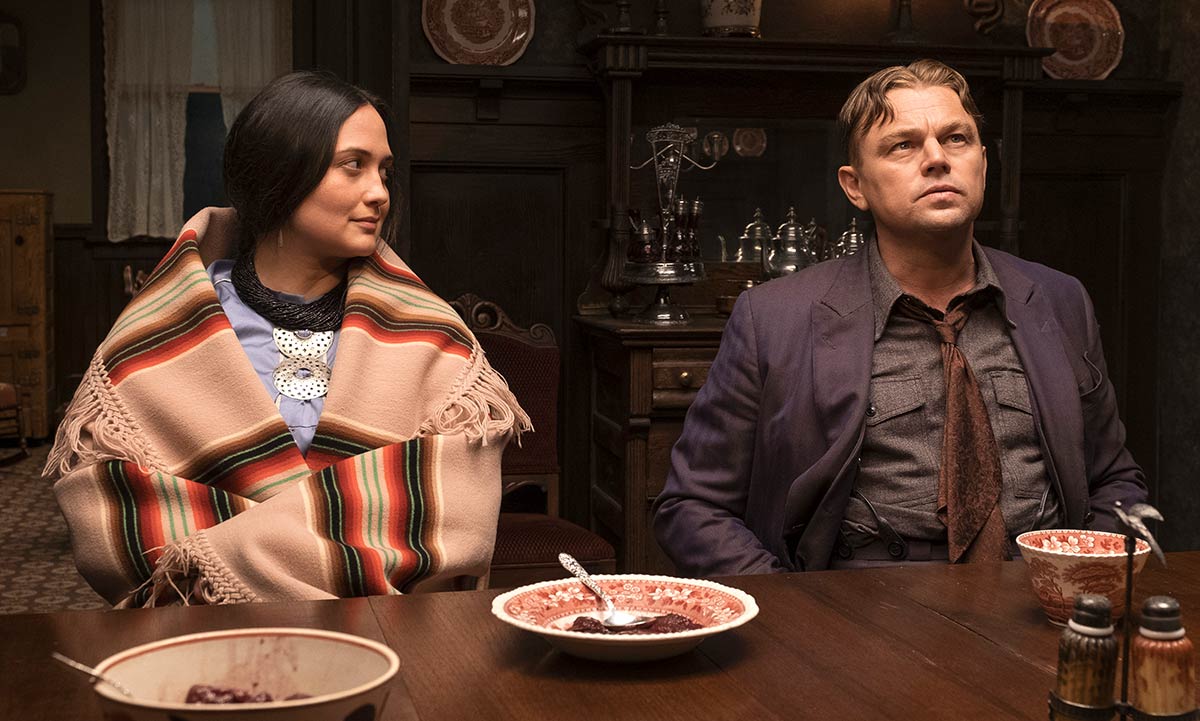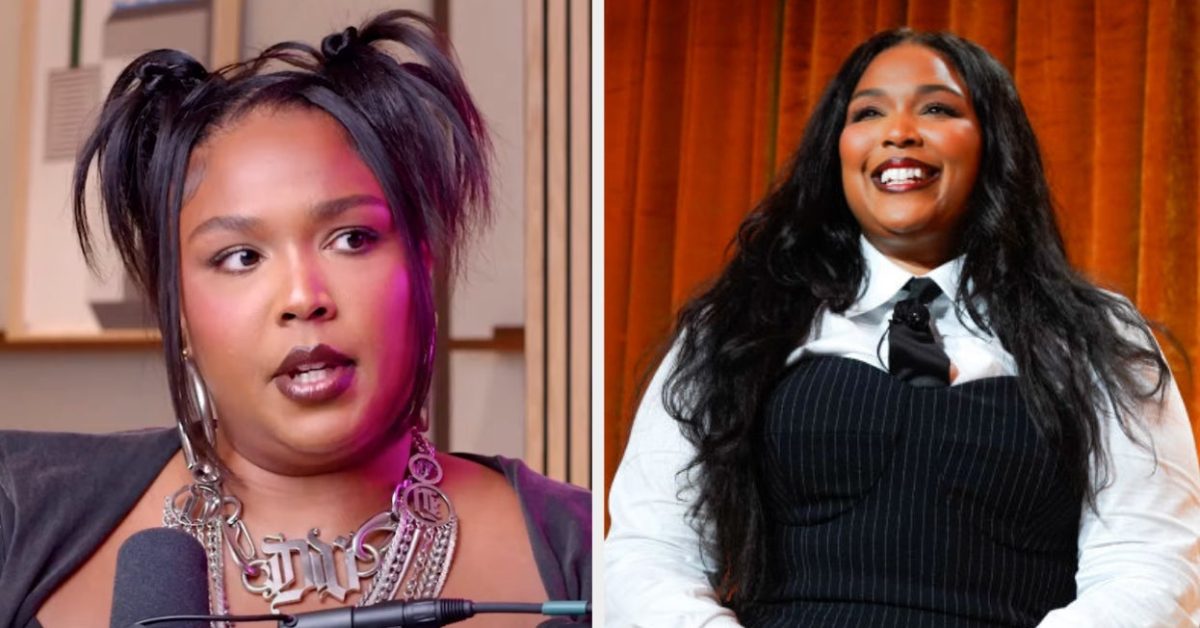
Lily Gladstone Devastates in Indigenous Epic
May 22, 2023
I am still searching for my words; my thoughts first ran dry in the opening minutes of the shattering and evocative “Killers of the Flower Moon.” It begins with the Osage tribal elders mourning the loss of their language and customs as they bury a sacred pipe. The scene breaks, next revealing these Indigenous folks — forcibly moved from Missouri to present-day Oklahoma (thought to be terrible, barren land) — discovering oil as psychedelic music erupts with the splash of the black liquid. A black-and-white newsreel montage — with intertitles — explains how the Osage nation received generational wealth from the discovery of black gold, allowing them to send their children to country clubs and universities, where they were assimilated and taken further away from their culture. It’s a swift opening that foreshadows the root of the pain that will visit these children and their children and the fits of greed and white supremacy that will target them.
READ MORE: Lily Gladstone Almost Quit Acting Before ‘Killers of the Flower Moon’
The cinematic adaptation of David Grann’s same-titled novel by writer/director Martin Scorsese (he co-wrote the script with Eric Roth) doesn’t come without some risk. This is inherently an Indigenous story. A white director taking it on brings with it deserved charges of exploitation and fears that another white person will once again whitewash Indigenous history. In “Killers of the Flower Moon,” those worries are not wholly unfounded. Though Scorsese took great lengths to bring on advisors, there are only so many blindspots one can be filled. To Scorsese’s credit, in this film, there are very few (but they are glaring).
“The Killers of the Flower Moon” moves with his signature precision, nimble eye, and soulful interpretation of turbulent communities and the rot that can take hold in one.
The decay in Fairfax, Oklahoma, has been metastasizing for years with a series of unexplained deaths of Osage men and women. Other than the victims’ race, what binds them together are their spouses. They’re white, and they stand to inherit their deceased partner’s oil rights. Ernest Buckhart (Leonardo DiCaprio) returns to Fairfax at the conclusion of World War I. Though many hail him as a hero, he merely served food to the soldiers as a line cook. His uncle William Hale (Robert DeNiro) — who goes by uncle or king — has promised him a job as a taxi driver. Though William sells himself as a friend to the Osage people, he is a calculating puppet master who moves with brutal silence to bring further wealth into the family. He directs the simple-minded Ernest to settle down and start a family with the eligible and wealthy Mollie (Lily Gladstone). Whether Ernest truly loves Mollie or is just an idiot or malicious fiend is a fine line that DiCaprio will spend the next three hours straddling.
See, Mollie is battling diabetes (a near death sentence in the early 20th century). She is just one of many Osage men and women affected by diseases brought on by their integration into white society. At one point, Mollie is told she won’t survive if she lives by the white man’s diet of sweets. Elsewhere, we see the Indigenous people battling melancholia (depression) through alcohol, wasting away or prone to violence, often instigated by the racism inflicted on them by racist white people. Osage people rarely live past 50, and no one is doing anything about what constitutes a slow genocide through institutional — the doctors, coroners, and sheriffs — means. Hale accelerates the erasure of a people when he decides to pursue Mollie’s family. What follows is over an hour of bloody murders and state-sponsored violence carried out by Hale and Ernest, a tandem that shows how closely evil lurks on the surface.
Clocking in at 206 minutes, “Killers of the Flower Moon” displays tremendous vigor and vitality through the early going. That’s to do with Robbie Robertson’s rumbling and rustling score, slide guitars that slice open the mood to pour intoxicating notes onto immaculate compositions that suggest how much care Scorsese and cinematographer Rodrigo Prieto are taking in recharging history. Crimson reds, forest greens, and brushed beiges paint the sprawling scenes and the vivid garb. Ethereal rays and hellish hues mark the community’s steady decline, while the lithe camera, which devours every detail on this vast canvas, acutely balances the epic with the intimate. How Thelma Schoonmaker manages to stitch together Scorsese’s visual playfulness — there is much, from a Silent Cal joke to changes in medium — is still a wonder to behold.
As are the performances. Seeing DiCaprio (who veers to a better version of his performance in “J. Edgar”) and DeNiro match wits allows the film to remain in a liminal space where the characters’ intentions are clear yet unconfirmed. Jesse Plemons emerging as Tom White — an investigator sent by the government to discover the truth about the murders — offers further gravitas and pierces through the bubble of the West once again to quietly subvert the expectations of the genre. But it’s Gladstone who is the clear highlight.
There’s just one problem.
Though the director and the actor try, there is simply not enough of her. Scorsese attempts to grant us her interiority through his tried and true methods: twenty brief POV shots take us in her head, her vision granting us a picture of the slings and arrows she takes from white people’s venomous glances. Her narration tells us the fear, anger, and rightful paranoia that occurs when the cruel panopticon of white supremacy is ever-present. The scenes come off so well that you’re left craving and wanting much more. You want less rooting through the vile actions of these white folks — which only serves them, even as villains — and more of the ripe emotional vein that building out Mollie can provide.
Gladstone does her part, too; she and Scorsese are a devastating partnership. She is risky and patient, saucy and stoic, soulful and keen, raw yet so controlled. Scorsese further reveals those characteristics with a lens fully addicted to the actress, capturing how her spark lights the frame with a deft touch. Gladstone’s unshakable rise — she rattled the festival circuit with tremendous performances in “Fancy Dance” and “The Unknown Country” — is sent into overdrive here, even though she doesn’t envelope enough of the film. When she isn’t on the screen, this 206-minute movie, which moves at an invigorating pace through its first half, begins to tire and slow (while an allusion to the Tulsa Massacres feels misplaced and left dangling).
Instead, Scorsese finds the need to document the trial resulting from the murders, along with the backroom dealing, loaded hypocrisy, and cleansing of the soul (both in a literal sense and religious context) that takes over. The film becomes less about Mollie and more about the internal battle occurring within Ernest. How will he defend his family? How will he protect Mollie? Can he make one decision on his own without the overbearing eye of his uncle? The answers to these questions fill the second half as Scorsese works through the particulars of what happened and who’s responsible. We don’t, however, really need the courtroom proceedings or the play-by-play, which retreads already forged ground. The actors — DeNiro, Plemmons, John Lithgow and Brendan Fraser as lawyers, and especially DiCaprio—are game and give meat to the scenes. But it feels too locked to the perspective of white guilt and white punishment that feels misplaced when the story is right there with Mollie.
That doesn’t mean Scorsese is unaware that it’s an Osage narrative. In the film’s final sequence — which playfully moves the proceedings from a stuffy courtroom environ and claustrophobic jail cells to a radio play — he punches the film home by recentering the perspective. Without spoiling too much, the first swing comes from a trusted voice (putting that person’s integrity and relationship with the audience on the line), and the next is given by the Osage people themselves (this time in a modern milieu). The last-second recalibrations are just enough to put a bow on a film that sees Scorsese in near aesthetic and sonic control, even if the narrative leaves much to be desired. “The Killers of the Flower Moon,” a visceral epic, is the story of the wreckage of a people, the evil in white men’s hearts and the poison they spread, and the erasure that occurs when their stain touches you. It’s powerful, even when you’re left wondering if someone else could’ve spread the gospel. [B]
Follow along with all our coverage from the 2023 Cannes Film Festival
Publisher: Source link
"All Of This Came Out Of Nowhere": Lizzo Publicly Responds To Sexual Harassment Lawsuits After Being Dismissed From A Case
"We're continuing to fight the other claims."View Entire Post › Disclaimer: This story is auto-aggregated by a computer program and has not been created or edited by filmibee.Publisher: Source link
Dec 27, 2024
This Fan-Favorite Elf Quote Almost Didn’t Make It Into the Film
11. Determined to maintain the old school aesthetic, Favreau told Rolling Stone he didn’t want to make the film “a big CGI extravaganza," only using the technology to add some snow. “I like motion-control, models, matte paintings,” he explained. “It…
Dec 27, 2024
Guess The Missing Word: Christmas Song Titles
The holidays are here, and there's no better way to ring it all in than a seasonal song or two. So test your yuletide knowledge by identifying the missing word in the 14 holiday songs below. Good luck! Disclaimer: The…
Dec 26, 2024
Score an Extra 40% off Fashion & More
Our writers and editors independently determine what we cover and recommend. When you buy through our links, E! may earn a commission. Learn more. Even on Christmas Day, Anthropologie has your back with an extra 40% off sale that’s practically a…
Dec 26, 2024











